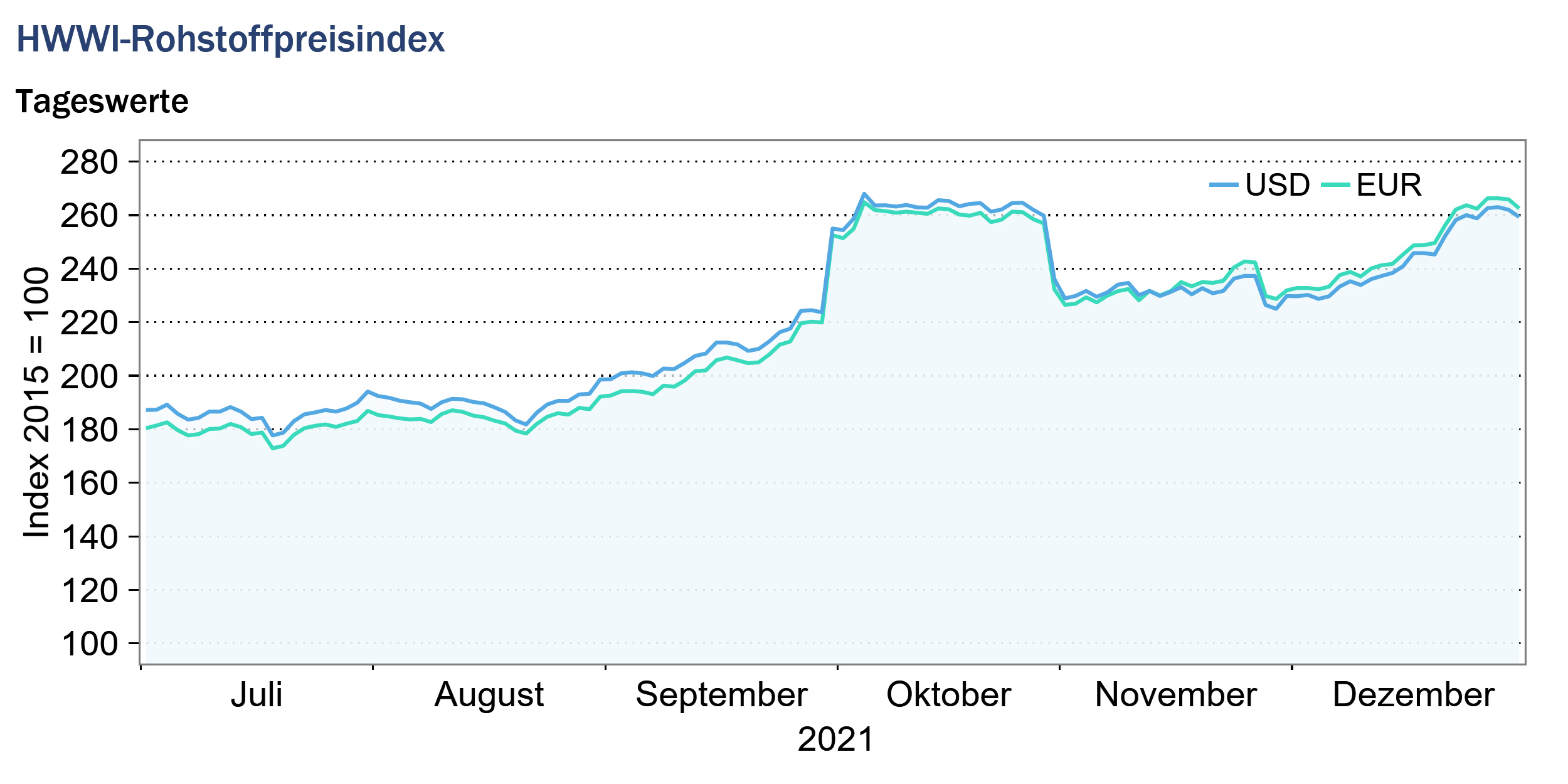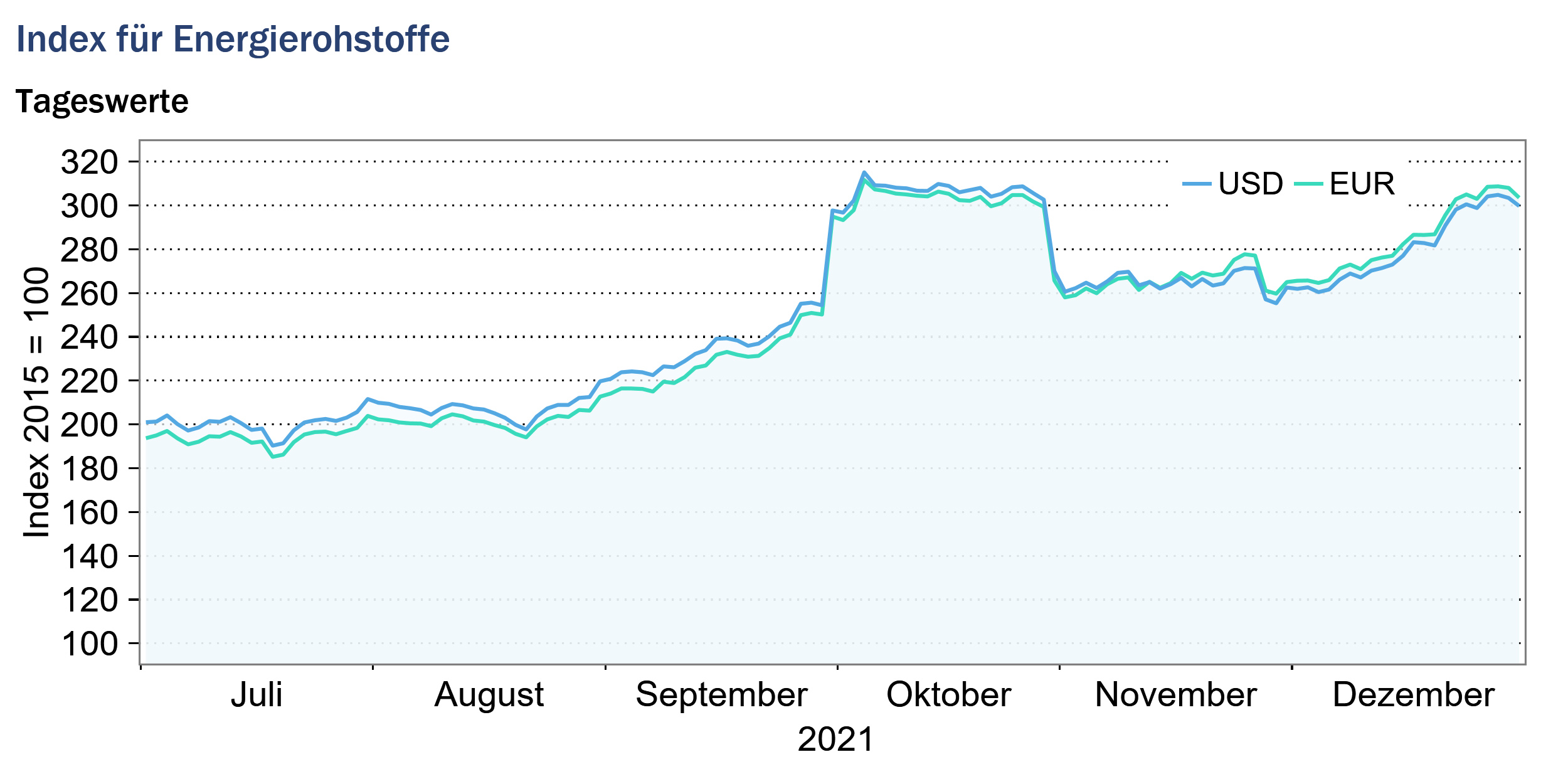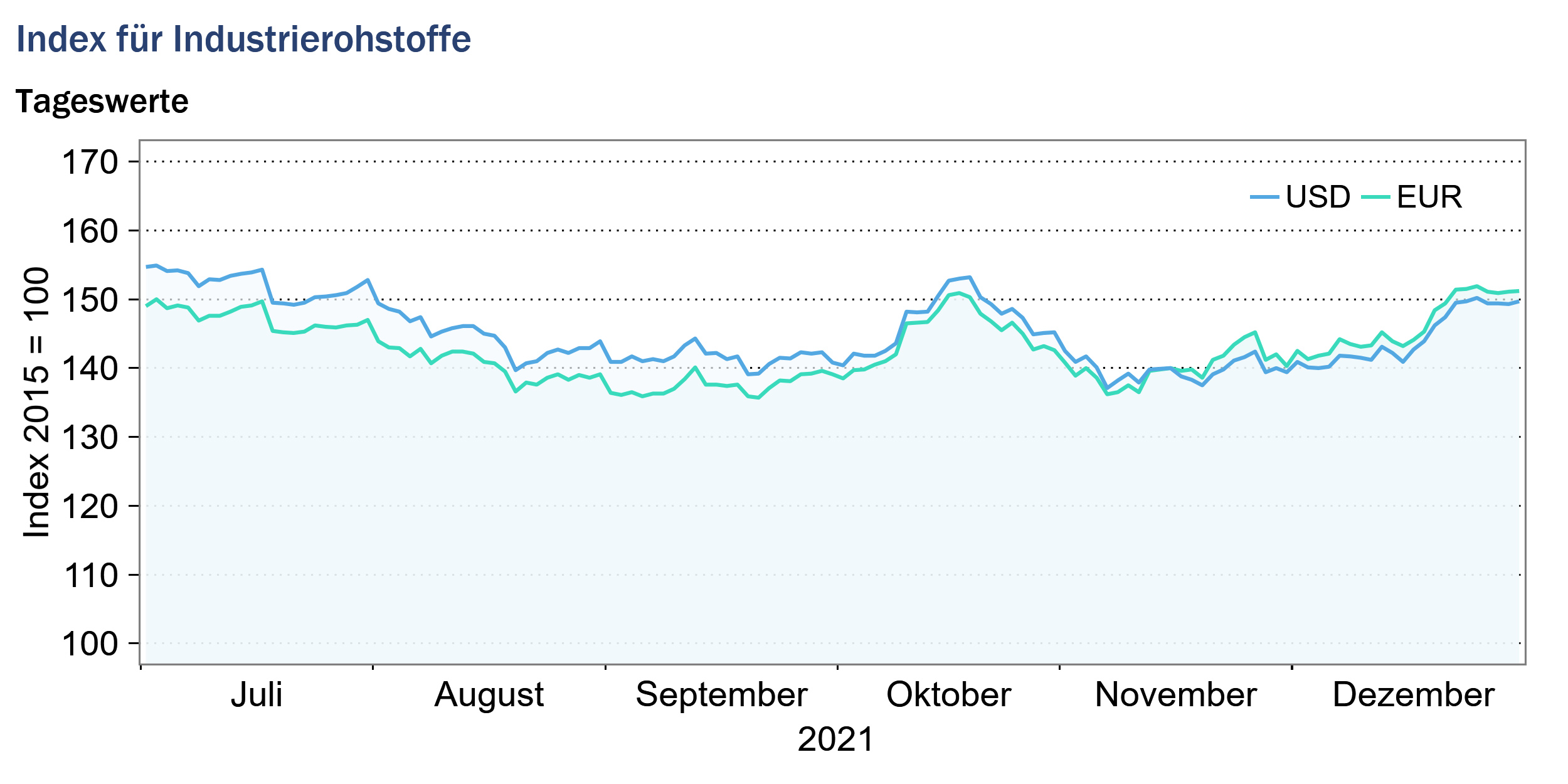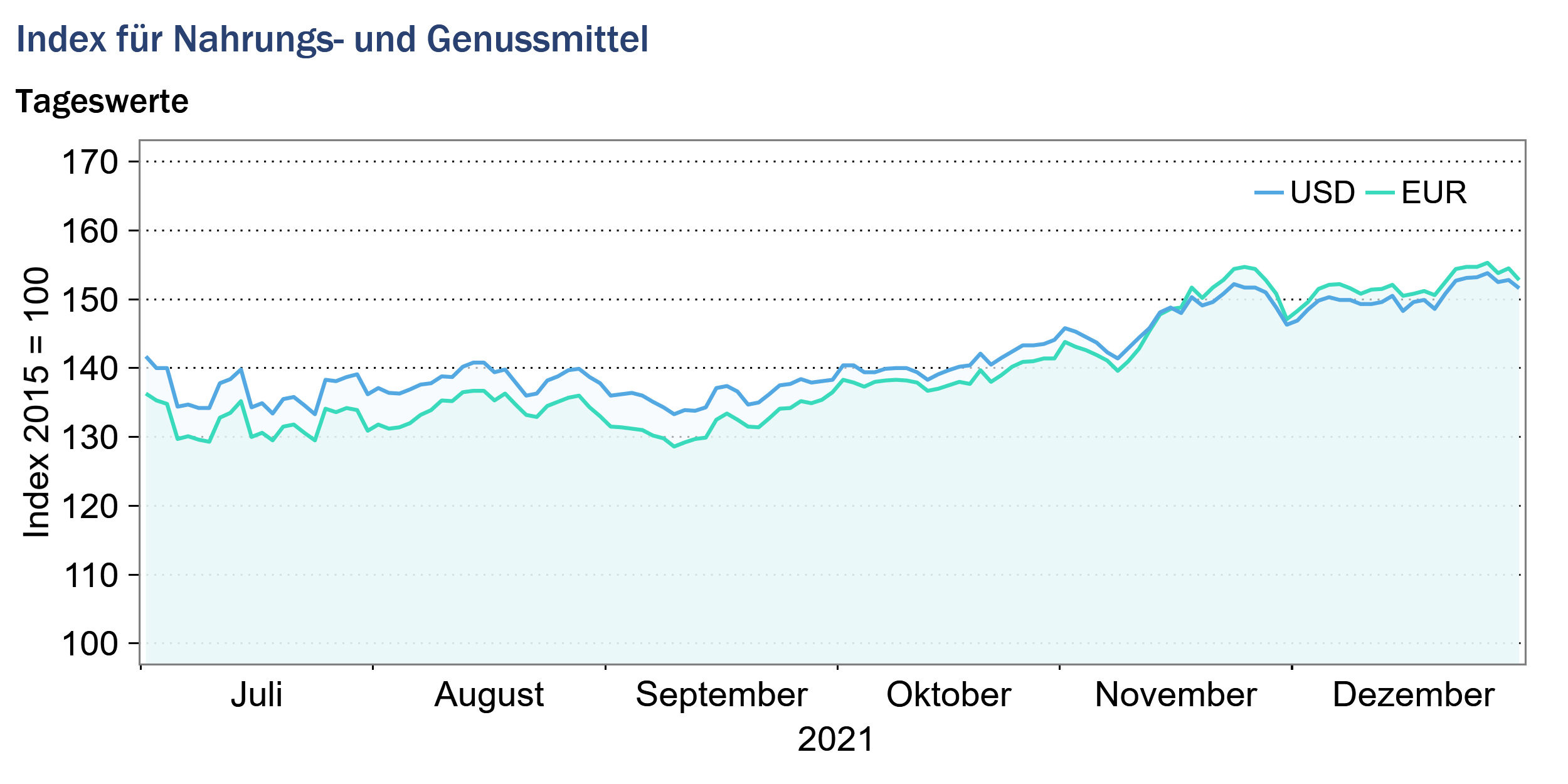HWWI commodity price index rose in December
- HWWI overall index rose by 5.3 % (US dollar basis)
- Crude oil prices fell by 7.9
- Natural gas prices rose by 22.3
(Hamburg, January 11, 2022) The HWWI commodity price index rose by an average of 5.3% in December compared with the previous month. All three sub-indices of the HWWI Commodity Price Index, the index for energy commodities, the index for industrial commodities and the index for food and beverages, increased on a monthly average. The prices included in the index for energy raw materials moved in opposite directions. Prices for natural gas and coal continued to rise sharply in December, while crude oil prices recorded losses. On the markets for industrial raw materials, prices for iron ore and lumber in particular increased significantly. Prices for food, beverages and tobacco also increased slightly in December compared with the previous month, as the price of coffee, for example, continued its month-long upward trend.

Energy commodities index: +5.7% (euro basis: +6.8%)
Crude oil prices continued to fall on average in December, reflecting uncertainty on the crude oil market with regard to rising corona infections worldwide and thus expectations of falling demand on the one hand, and rising supply on the other. Prices for European benchmark Brent crude averaged $74.91 per barrel and U.S. benchmark WTI crude $71.76 per barrel for the month. Crude oil supply was strengthened from three sides at once in December. Firstly, despite low prices, OPEC+ is sticking to its monthly gradual lifting of production cuts and increased daily output by a further 400,000 barrels in December as planned. In addition, the U.S. government brought crude oil from government reserves to the market, and third, U.S. producers expanded production as high crude oil prices in the fall made shale oil production seem lucrative again. In contrast, the global spread of the omicron variety increased uncertainty about crude oil demand trends. Lockdown measures and a worsened macroeconomic outlook could cause demand for crude oil to slump again in the future.
In contrast to crude oil prices, coal prices increased on average in December compared with the previous month, due to the rise in Australian coal prices. While Australian coal prices increased by 7% on average for the month, South African coal prices fell by 3.3%.
Prices for natural gas also rose again in December compared with the previous month. In particular, prices for European natural gas made up for the previous month’s losses, rising by almost 26% on average for the month. The increase can be explained by the shortage of European natural gas supplies by the Russian group Gazprom. In addition, the cold season further increased European natural gas consumption, which led to high prices in low-filled natural gas storage facilities. In contrast, natural gas prices in the U.S. fell on average in December compared with the previous month as U.S. natural gas supply increased and currently exceeds domestic demand. Due to high European natural gas prices, natural gas exports from the U.S. to Europe are increasing.
Overall, the energy commodities subindex rose by 5.7% (euro basis: +6.8%) to 279.7 points (euro basis: 283.9 points).

Index for industrial raw materials: +3.6% (euro basis: +4.6%)
The sub-index for industrial raw materials, which is divided into the index for agricultural raw materials, the index for non-ferrous metals and the index for iron ore and steel scrap, rose by 3.6% in December compared with the previous month. Prices for agricultural raw materials and for iron ore and steel scrap drove up the value of the index, while prices for non-ferrous metals recorded only a slight increase on average.
After the sharp price declines of recent months, iron ore prices picked up again for the first time in December, rising by 15% from the previous month. The decline in iron ore prices in recent months was due to Chinese steel production being cut back on the one hand to save electricity in view of the energy shortage and on the other to reduce the country’s CO2 emissions. Since the middle of November, iron ore prices have risen again as steel production in China is expected to increase again after reaching the emissions reduction target for this year.
Prices for non-ferrous metals recorded opposing trends in December. Prices on the markets for aluminum and zinc increased on average for the month. The continuing rise in prices for natural gas and coal caused a decline in energy-intensive production of the two metals. By contrast, prices for copper and lead fell on average in December compared with the previous month. Copper prices thus responded to market uncertainty caused by the rapid global spread of the new virus variant Omikron. The price of copper is considered an economic barometer and reflects expectations for the development of the global economy.
Lumber prices rose particularly sharply in December, by more than 30% compared with the previous month. The supply of lumber remained tight as transport routes were destroyed and sawmills closed as a result of flooding in Canada, a major lumber producer. The shortage of supply was met by high demand, resulting in a sharp rise in prices.
Overall, the index for industrial raw materials rose by +3.6% (euro basis: +4.6%) to 144.8 points (euro basis: 146.6 points) on a monthly average.

Index for food, beverages and tobacco: +2.1% (euro basis: +3.1%)
The index for food, beverages and tobacco rose by an average of 2.1% in December compared with the previous month and was thus 28.9% higher than the corresponding year-earlier figure. All three sub-indices, the index for cereals, the index for luxury foods, and the index for oils and oilseeds, rose slightly in December.
Corn and soybean prices increased in December from the previous month. The price increase was due to hot and dry weather in key growing areas in Argentina and southern Brazil. The weather is clouding crop prospects and causing prices to fall. Wheat prices, on the other hand, did not continue the upward trend of recent months in December. In its extensive crop forecasts, the United States Department of Agriculture (USDA) revised crop volumes upward in important producing countries such as Australia, Russia and Canada. The correction has been reflected in falling world wheat prices.
Prices for vegetable oils also fell in December. Prices for soybean oil fell particularly sharply, but prices for palm, coconut and sunflower oil also recorded losses in December compared with the previous month.
Prices for luxury foodstuffs again moved in opposite directions in December. While coffee and tea prices rose, sugar and cocoa prices fell compared with the previous month. The price of coffee continued its month-long upward trend, leaving its ten-year high behind. Supply from Brazil remains tight as poor weather conditions in key growing regions reduced the crop and global supply chains were also affected by the Corona pandemic. While supply remained tight in December, global demand for coffee was stable.
Sugar prices fell in December compared to the previous month. On the one hand, the spread of the new Omikron virus variant increased concerns about further lockdown measures that would lead to a decline in sugar demand. On the other hand, lower crude oil prices led to a decline in ethanol demand, which in turn led to a decline in sugar prices.
Overall, the food and beverage index rose by an average of 2.1% for the month (euro basis: +3.1%) and stood at 150.5 points (euro basis: 152.1 points).

Source: www.hwwi.org
